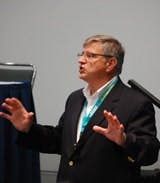Amazing Results Highlighted in Food & Beverage Forum
"I closed my control room. All of my operators are out in the plant with portable HMIs," declared Tim Foster, vice president of engineering and joint founder of Green Planet Farms (GPF). "I've got 25% of the staff I had before, and they're more qualified people," he said as he and Steve Schiedemeyer, vice president of engineering at Engineering Solutions Experts (ESE), discussed the results of the project GPF did with ESE, a major Wisconsin-based system integrator and Rockwell Automation Solution Provider.
"My partner and CEO went to see a plant that was producing soy protein isolates using water instead of hexane. She came back and told me that she wanted a plant that worked just like that one. So we got with ESE and did it," Foster explained. "After we had been in operation for a few months, I visited the other plant, and found out that they had no automation at all—it was entirely manual! If I had known that, we might not have the plant we have now."
The design involved cutting-edge technologies using the Rockwell Automation PlantPAx process automation system and systems and equipment from a range of Rockwell Automation's Encompass Program partners. "Our system integrator truly integrated the project," Foster said. "They used the ControlLogix automation platform, FactoryTalk View SE (Site Edition) on wireless HMIs, Endress+Hauser instrumentation, Hardy Instruments weight controllers, other third-party proprietary equipment and processes, multiple Allen-Bradley IntelliCenter motor control centers and data acquisition based on FactoryTalk Transaction Manager with Microsoft Reporting Services.
The use of wireless technology provided by ProSoft was key to the success of the implementation because it made the HMI mobile. "We are extremely pleased with the wireless portion of the project," Foster said. "We have been up for a year, with no downtime caused by the wireless system and no dead spots either. Operators can be anywhere, and they can make changes to the system from their mobile Panasonic Toughbook handheld HMIs anywhere."
The use of Integrated Architecture and the ControlLogix platform came up again in Scott Young's presentation. A dairy expert from Maverick Technologies, Young described using advanced technologies and the Logix platform to drive greater efficiency across six plants of the eleven owned by Darigold, the fourth largest dairy co-operative in the US. The plants, located in Jerome, Sunnyside, Seattle, Linden and Spokane, Wash., and in Caldwell, Idaho, are separated by, in some cases, several hundred miles and a mountain range.
Although the Darigold project manager, Brent Baker, wasn't present, Young relayed his comments. "Baker feels their decision to standardize on one platform was huge from a troubleshooting standpoint," Young said. "One platform across the plant, integrated from raw milk receiving to the warehouse."
Young noted that Darigold, "partnered with Maverick Technologies as a main automation contractor (MAC), for engineering design, PLC programming, HMI screen development, and coordinating information from the process and OEM equipment. This insured they had a consistent way to access information across the entire plant, rather than have each vendor working in its own sandbox, then creating interfaces to upstream/downstream equipment, and the problems inherent in that approach."
After the integration, Young said, "I can access any part of any of the plants securely from my living room, and the data is available at the enterprise level for supply chain optimization too."
Even more amazing was the project done by Dave Spryshak of General Mills with Rockwell Automation's Power and Energy Management Services organization. "We were told in 2005 to reduce our energy footprint by 15% in 5 years," Spryshak said, "and a little calendar math will tell you that's next year."
"We discovered that the single biggest energy consumer in our plants was the HVAC system." Spryshak and the PEMS team discovered that by applying process control principles to the control of airflow in plant buildings, they could improve air quality indoors and out and reduce electricity use 17% to 49%. Gas usage was reduced 14% to 63%. In one case, Spryshak was able to reduce electricity consumption 3 MW, and saved $1.5 million in a single year.
They used cascading loop control for air volume, an enthalpy algorithm to utilize the least-cost energy source, multiple room space recipes, and used carbon dioxide measurement to determine room occupancy and derive airflow requirements.
General Mills and Rockwell Automation PEMS have modified 16 plants and are rolling out the changes across the rest of the enterprise as required.
From optimizing plant-wide control, the forum segued into optimizing energy usage, first with the General Mills example, and then with a short tutorial on how to do an energy-management project by Ray Zimmermann of RJZ LLC. Zimmermann repeated what General Mills' Spryshak said. "You have to change the corporate culture to make sure that energy saving projects will continue to perform properly."
Zimmermann said that top level management buy-in was critical to energy optimization project success. He said that it was necessary to make it a company priority, establish structure and committees, identify key personnel at each level of management and establish an energy mission—that is, integrate energy into overall company strategies. Then establish objectives for energy accounting and data requirements and develop a plan to heighten communication and make energy a visible priority.
After that, Zimmermann said, you can select partners with experience, set leadership priorities and move forward to study and audit energy usage. Once you have completed the audit, you can prioritize the energy saving projects you want to complete, and then get to work.


